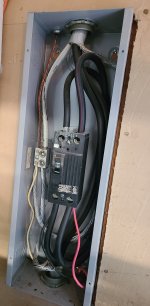230.46 Spliced and Tapped Conductors.
Service-entrance conductors shall be permitted to be spliced or tapped in accordance with 110.14, 300.5(E), 300.13, and 300.15. Power distribution blocks, pressure connectors, and devices for splices and taps shall be listed. Power distribution blocks installed on service conductors shall be marked "suitable for use on the line side of the service equipment" or equivalent.
Statement of Problem and Substantiation for Public Comment
This Public Comment would relocate verbiage added in a new Section 230.11 (FR 8454) to this existing Section. This Public Comment would also make changes to the requirements in FR 8454, as described below: This First Revision went beyond relocating “Service Requirements” for power distribution blocks and pressure connectors to also requiring both types of devices be rated “suitable for use on the line side of the service equipment”. In the case of power distribution blocks, this designation is based on the application of a Short Circuit Current Rating without the benefit of an upstream overcurrent protective device. This is consistent with 2017 Code language in 314.28(E)(1) and 376.56(B)(1), and consistent with the listing of Power Distribution Blocks, which may be evaluated and marked as being “suitable for use on the line side of the service equipment”. Wire connectors are not, by themselves, listed as being “suitable for use on the line side of the service disconnect”, although a connector may be part of a listed assembly (such as a panelboard) that is rated for “service equipment”. A connector that isn’t part of equipment, such as an insulated splicing wire connector, is used to join conductors of the same polarity or phase. The connectors are insulated to provide dielectric protection for the voltage rating of the connector from short circuiting to another uninsulated conductor or grounded metal. The connectors are not permanently affixed to the enclosure. Instead, they are floating free inside the enclosure, supported by the wires connected to them. As such, these connectors move with any force they may be subjected to, including those experienced under a short circuit condition, so that a conductor is not likely to pull out of the connector. Power distribution blocks are intended to be permanently fixed within an enclosure and may be used to terminate conductors of opposite polarity or phase and ground (similar to a wire connector that is an integral part of a panelboard). They utilize terminals that rely on through air and over surface spacings to maintain the proper distances between conductors based on the voltage rating of the power distribution block. These spacings are intended to prevent arcing and short circuiting between connectors of different voltage potentials. Because power distribution blocks are not free floating in the enclosure, they must have the ability to withstand opposing forces so that conductors do not pull out of the terminals and potentially short circuit to each other or to ground during a short-circuit condition. Power distribution blocks marked as “suitable for use on the line side of the service equipment” are evaluated without an overcurrent protective device and are subjected to the short circuit current for a duration of no less than three electrical cycles.{/quote]


